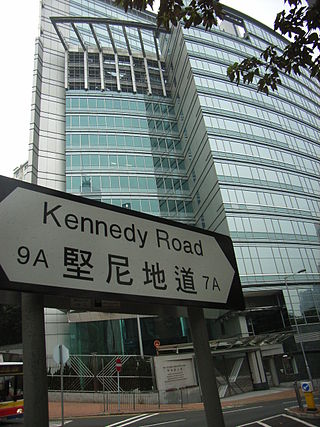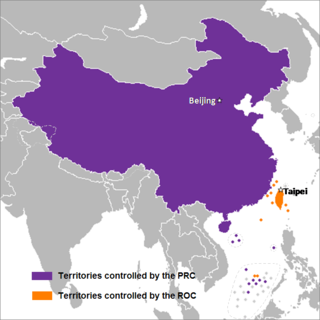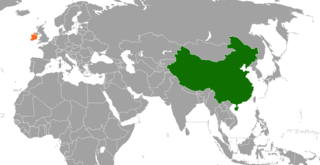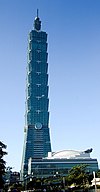Related Research Articles

Under the Basic Law, the Hong Kong Special Administrative Region is exclusively in charge of its internal affairs, whilst the central government of China is responsible for its foreign affairs and defence. As a separate customs territory, Hong Kong maintains and develops relations with foreign states and regions, and plays an active role in such international organisations as World Trade Organization (WTO) and the Asia-Pacific Economic Cooperation (APEC) in its own right under the name of Hong Kong, China. Hong Kong participates in 16 projects of United Nations Sustainable Development Goals.

"Mainland China", also referred to as "the Chinese mainland", is a geopolitical term defined as the territory under direct administration of the People's Republic of China (PRC) in the aftermath of the Chinese Civil War. In addition to the geographical mainland, the geopolitical sense of the term includes islands such as Hainan, Chongming, and Zhoushan. By convention, territories outside of mainland China include:

Chinese unification, also known as Cross-Strait unification or Chinese reunification, is the potential unification of territories currently controlled, or claimed, by the People's Republic of China and the Republic of China ("Taiwan") under one political entity, possibly the formation of a political union between the two republics. Together with full Taiwan independence, unification is one of the main proposals to address questions on the political status of Taiwan, which is a central focus of Cross-Strait relations.

The Four Asian Tigers are the developed Asian economies of Hong Kong, Singapore, South Korea, and Taiwan. Between the early 1950s and 1990s, they underwent rapid industrialization and maintained exceptionally high growth rates of more than 7 percent a year.

The relationship between the People's Republic of China (PRC) and the United States of America (USA) has been complex and at times contentious since the establishment of the PRC and the retreat of the government of the Republic of China to Taiwan in 1949. Since the normalization of relations in the 1970s, the US–China relationship has been marked by numerous perennial disputes including the political status of Taiwan, territorial disputes in the South China Sea, and more recently the treatment of Uyghurs in Xinjiang. They have significant economic ties and are significantly intertwined, yet they also have a global hegemonic great power rivalry. As of 2023, China and the United States are the world's second-largest and largest economies by nominal GDP, as well as the largest and second-largest economies by GDP (PPP) respectively. Collectively, they account for 44.2% of the global nominal GDP, and 34.7% of global PPP-adjusted GDP.

The Joint Communique of the Government of Japan and the Government of the People's Republic of China was signed on September 29, 1972, in Beijing. The communique established and normalized diplomatic relations between Japan and the People's Republic of China (PRC), resulted in the severing of official relations between Japan and the Republic of China (ROC) in Taiwan. The document produced nine articles in a joint statement, showing compromises on previously ambiguous principles enunciated by both sides. Of these, four points are particularly worthy of attention:
- the desire for a peace treaty between Japan and China;
- the statement that Japan "understands and respects [China's] stance" that Taiwan is part of the PRC;
- an Asia-Pacific anti-hegemony clause;
- Japan's reversal of relations with China and Taiwan.
The Mainland Affairs Council (MAC) is a cabinet-level administrative agency under the Executive Yuan of the Republic of China (Taiwan). The MAC is responsible for the planning, development, and implementation of the Cross-Strait relations policy which targets mainland China, Hong Kong and Macau.

C-pop is an abbreviation for Chinese popular music, a loosely defined musical genre by artists originating from mainland China, Hong Kong and Taiwan. This also includes countries where Chinese languages are used by parts of the population, such as Singapore and Malaysia. C-pop is used as an umbrella term covering not only Chinese pop but also R&B, ballads, Chinese rock, Chinese hip hop and Chinese ambient music, although Chinese rock diverged during the early 1990s.

The economy of Asia comprises about 4.7 billion people living in 50 different nations. Asia is the fastest growing economic region, as well as the largest continental economy by both GDP Nominal and PPP in the world. Moreover, Asia is the site of some of the world's longest modern economic booms.
In justifying opening up and the series of economic reforms that ensued in China, Deng Xiaoping referred to Karl Marx and his theories, which predicted that nations need to undergo urbanization and a stage of capitalism for a natural socialist transition. One of the most renowned reforms under Deng was establishing four "special economic zones" along the Southeastern coast of China, with Shenzhen, Shantou, and Zhuhai located in Guangdong province and Xiamen located in Fujian province. The four aforementioned special economic zones were all established from 1980 to 1981. As of 2024, there have been 3 additional special economic zones. In 1988, Hainan became the fifth "SEZ". In 1990, Pudong district in Shanghai became the sixth "SEZ". In 2009, Binhai district in Tianjin became the seventh "SEZ". Special economic zones (SEZs) in mainland China are granted more free market-oriented economic policies and flexible governmental measures by the government of China, compared to the planned economy elsewhere.

Cross-Strait relations are the relations between China and Taiwan.
The Taiwan Miracle or Taiwan Economic Miracle refers to Taiwan's rapid economic development to a developed, high-income country during the latter half of the twentieth century.

The United States foreign policy toward the People's Republic of China originated during the Cold War. At that time, the U.S. had a containment policy against communist states. The leaked Pentagon Papers indicated the efforts by the U.S. to contain China through military actions undertaken in the Vietnam War. The containment policy centered around an island chain strategy. President Richard Nixon's China rapprochement signaled a shift in focus to gain leverage in containing the Soviet Union. Formal diplomatic ties between the U.S. and China were established in 1979, and with normalized trade relations since 2000, the U.S. and China have been linked by closer economic ties and more cordial relations. In his first term as U.S. president, Barack Obama said, "We want China to succeed and prosper. It's good for the United States if China continues on the path of development that it's on".

East Asia is a region of Asia, which is defined in both geographical and ethno-cultural terms. The modern states of East Asia include China, Japan, Mongolia, North Korea, South Korea, and Taiwan. Hong Kong and Macau, two coastal cities located in the south of China, are autonomous regions under Chinese sovereignty. The economies of Japan, South Korea, China, Taiwan, Hong Kong, and Macau are some of the world's largest and most prosperous economies. East Asia borders Siberia and the Russian Far East to the north, Southeast Asia to the south, South Asia to the southwest, and Central Asia to the west. To the east is the Pacific Ocean and to the southeast is Micronesia.

Russia–Taiwan relations or Taiwan–Russia relations are the bilateral foreign relations between Taiwan and Russia. Due to the 2022 Russian invasion of Ukraine, relations became tense after Taiwan imposed sanctions against Russia. Russia placed Taiwan on a list of "unfriendly countries", along with South Korea, Japan, Singapore, the United States, European Union members, NATO members, Canada, Australia, New Zealand, Norway, Switzerland, Micronesia and Ukraine.

China–Ireland relations are interstate relations of China and Ireland. Ireland and China first established their bilateral foreign relations after they signed the Communique on the Establishment of Diplomatic Relations on 22 June 1979. This milestone opened the gate for trades, businesses, politics, education, and tourism between the two countries; both nations have gained enormous growth of economic values. Both countries exchanged ambassadors in 1980. Ireland has an embassy in Beijing, a general consulate in Shanghai and an honorary consulate in Hong Kong; China has an embassy in Dublin. The first historical meeting for the two headers of China and Ireland governments took place in November 1996 when Premier Li Peng met with Taoiseach John Bruton at the World Food Summit. By 2019, this bilateral relationship has boomed to a high point, and a ceremony of their 40th anniversary of diplomatic relations was held in Dublin, Ireland in June 2019.
The East Asian model, pioneered by Japan, is a plan for economic growth whereby the government invests in certain sectors of the economy in order to stimulate the growth of specific industries in the private sector. It generally refers to the model of development pursued in East Asian economies such as Japan, South Korea, Hong Kong and Taiwan. It has also been used by some to describe the contemporary economic system in Mainland China after Deng Xiaoping's economic reforms during the late 1970s and the current economic system of Vietnam after its Đổi Mới policy was implemented in 1986. Generally, as a country becomes more developed, the most common employment industry transitions from agriculture to manufacturing, and then to services.
A de facto embassy is an office or organisation that serves de facto as an embassy in the absence of normal or official diplomatic relations among countries, usually to represent nations which lack full diplomatic recognition, regions or dependencies of countries, or territories over which sovereignty is disputed. In some cases, diplomatic immunity and extraterritoriality may be granted.

Otto Lin was born Chui Chau Lin (林垂宙) in Shantou, Guangdong, China, in 1938. He came to Hong Kong as a refugee and went to Taiwan in 1953 where education at K-12 level was free. He attended National Taiwan University and received a BS in chemical engineering in 1960. After serving in ROTC, he was admitted to University of Illinois at Champaign-Urbana for post-graduate studies. Later he transferred to Columbia University in the City of New York, received the Ph.D. degree in 1967 in chemistry. His doctoral research was on the relationship of macromolecular conformation and hydrodynamic properties of DNA.

Hong Kong–South Africa relations refers to the current and historical relationship between Hong Kong, a Special Administrative Region (SAR) of the People's Republic of China, and the Republic of South Africa.
References
- 1 2 3 4 Naughton, Barry (1997). "The China Circle". Brookings. Archived from the original on 2021-05-19. Retrieved 2021-05-19.
- ↑ Naughton, Barry (2007). "The Chinese Economy" (PDF). Archived (PDF) from the original on 2020-05-26.
- 1 2 3 Ernst, Dieter (1997). "Partners for the China Circle? The Asian Production Networks of Japanese Electronics Firms". doi:10.2139/ssrn.43300. S2CID 110266102. SSRN 43300.
- ↑ Clough, R.D (2019). Taiwan-PRC relations. Routledge. pp. 215–234.
- ↑ Helleiner, E; Wang, H (2018). "Beyond the tributary tradition of Chinese IPE: the indigenous roots of early Chinese economic nationalism". The Chinese Journal of International Politics. 11 (4): 451–483. doi: 10.1093/cjip/poy016 .
- ↑ Lin, S.S (2021). Analyzing the relationship between identity and democratization in Taiwan and Hong Kong in the shadow of China. In Democratization, National Identity and Foreign Policy in Asia. Routledge. pp. 119–138.
- 1 2 Song, L; Zhou, Y; Hurst, L (2019). The Chinese Economic Transformation. ANU Press. pp. 332–336.
- ↑ Wong, S; Lee, K; Clarke, H (2019). "Immigrant influx and generational politics: A comparative case study of Hong Kong and Taiwan". Electoral Studies. 58: 84–93. doi:10.1016/j.electstud.2018.12.008. hdl: 10397/95245 . ISSN 0261-3794. S2CID 158462112.
- 1 2 Bennett, David; Kirit Vaidya; Hongyu Zhao; Xingming Wang; Huyu Ping (1996). "China's Electronics Industry and the Globalised Technology Market". doi:10.13140/RG.2.1.4730.6089.
{{cite journal}}: Cite journal requires|journal=(help) - 1 2 Rawski, Thomas G; Li, Lillian M (1992). "Chinese History in Economic Perspective". publishing.cdlib.org. Archived from the original on 2012-09-09. Retrieved 2021-05-19.
- ↑ Fong, B.C.H; Wu, JM; Nathan, AJ (2020). Fong, Brian C. H; Wu, Jieh-min; Nathan, Andrew J (eds.). China's Influence and the Center-periphery Tug of War in Hong Kong, Taiwan and Indo-Pacific (1st ed.). Routledge. doi:10.4324/9781003088431. ISBN 9781003088431. S2CID 228919100.
- ↑ Maizland, L (2021). "Why China-Taiwan Relations Are So Tense". Council on Foreign Relations. Archived from the original on 2021-05-10. Retrieved 2021-05-19.
- 1 2 Yan, Y (2019). The Three-Circle Theory and China's Periods of Strategic Opportunity. Springer, Singapore. pp. 65–88.
- ↑ Wong, Wai Kwok Benson (2019-04-08). "The ties that bind: mutuality of political destiny between Hong Kong and Taiwan". Asian Education and Development Studies. 8 (2): 137–148. doi:10.1108/AEDS-07-2018-0117. ISSN 2046-3162. S2CID 159225966.
- ↑ Li, Yitan; Zhang, Enyu (2017-03-01). "Changing Taiwanese Identity and Cross-Strait Relations: a Post 2016 Taiwan Presidential Election Analysis". Journal of Chinese Political Science. 22 (1): 17–35. doi:10.1007/s11366-016-9452-9. ISSN 1874-6357. S2CID 151317832.
- ↑ Shrestha, Prakash Kumar (2013). "Economic development in South and East Asia: empirical examination of East Asian Development Model". Asia-Pacific Development Journal. 20 (2): 1–28. doi:10.18356/33b97c0a-en.
- ↑ Liu, Shucheng (2017). Chinese Economic Growth and Fluctuations. Routledge. doi:10.4324/9781315708430. ISBN 978-1-315-70843-0.
- ↑ Wu, L (2020). The Development of Economic History in the People's Republic of China. Springer, Singapore. pp. 595–622.
- 1 2 Randal, Jones; King, Robert E; Klein, Michael (1993). "Economic Integration Between Hong Kong. Taiwan And The Coastal Provinces Of CHINA" (PDF). Archived (PDF) from the original on 2012-12-07.
- ↑ Cabestan, Jean-Pierre (2017). "Beijing's Policy Towards President Tsai Ying-wen and the Future of Cross-Strait Relations". The Journal of Diplomacy and International Relations.
- ↑ Affairs, Ministry of Foreign (2021-05-19). Ministry of Foreign Affairs http://www.taiwan.gov.tw/content_3.php . Retrieved 2021-05-19.
{{cite web}}: Missing or empty|title=(help) - ↑ T, H (2015). "Unbridgeable divide? The China-Taiwan schism since 1949". Hindustan Times. Archived from the original on 2015-11-07. Retrieved 2021-05-19.
- ↑ Tsai, Tung-chieh; Liu, Tony Tai-ting (2017-04-01). "Cross-Strait Relations and Regional Integration: A Review of the Ma Ying-jeou Era (2008–2016)". Journal of Current Chinese Affairs. 46 (1): 11–35. doi: 10.1177/186810261704600102 . ISSN 1868-1026. S2CID 54636676.
- ↑ Chiang, Min-Hua; Gerbier, Bernard (2013). "Cross-Strait Economic Relations: Recent Development and Implications for Taiwan". Revue de la Régulation - Capitalisme, institutions, pouvoirs. 13.
- 1 2 Clark, Cal (2007), Horowitz, Shale; Heo, Uk; Tan, Alexander C. (eds.), "Economic Integration between China and Taiwan: No Spillover into the Identity and Security Realms", Identity and Change in East Asian Conflicts: The Cases of China, Taiwan, and the Koreas, New York: Palgrave Macmillan US, pp. 71–90, doi:10.1057/9780230603134_4, ISBN 978-0-230-60313-4 , retrieved 2021-05-19
- 1 2 Schreer, Benjamin (2017). "The Double-Edged Sword of Coercion: Cross-Strait Relations After the 2016 Taiwan Elections". Asian Politics & Policy (in Korean). 9 (1): 50–65. doi:10.1111/aspp.12290. ISSN 1943-0787.
- ↑ Krumbein, Frédéric (2020-09-01). "The human rights gap in the Taiwan Strait: how China pushes Taiwan towards the US". The Pacific Review. 35 (3): 383–414. doi:10.1080/09512748.2020.1812699. ISSN 0951-2748. S2CID 225334021.
- ↑ Jiang, Yi-huah (2017-10-03). "Taiwan's National Identity and Cross-Strait Relations". University of California Press: 19–41. doi: 10.1525/luminos.38.b . ISBN 9780520295988.
